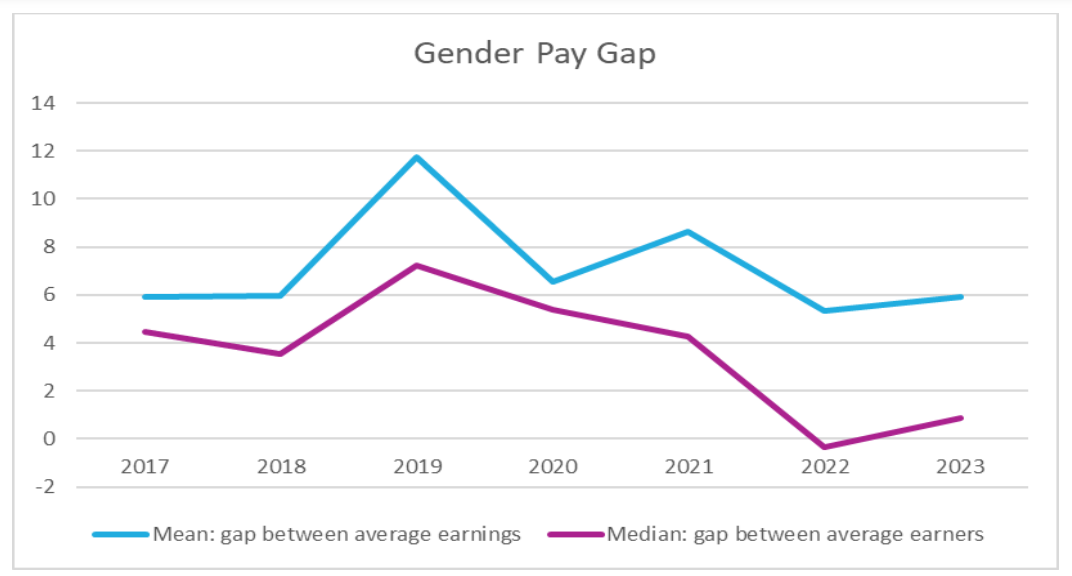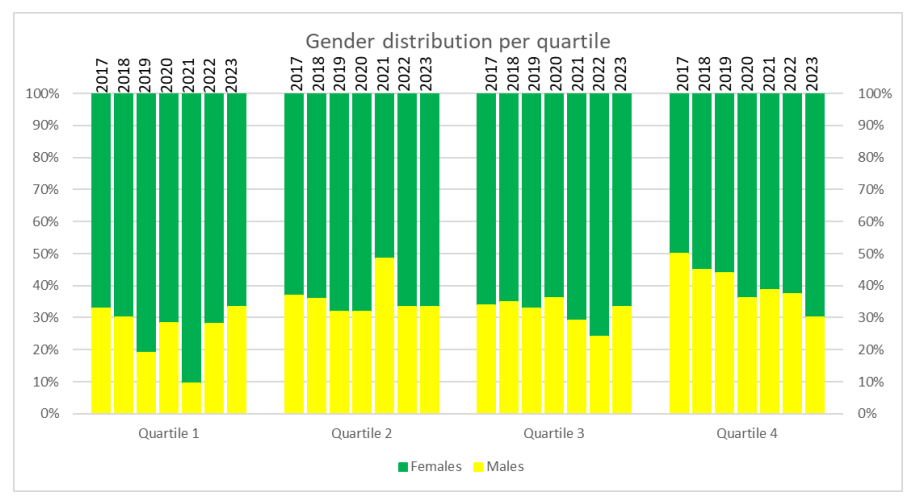Gender pay gap narrative
The Volunteering for Development (VfD) is our unique approach to how we work with poor and marginalised communities. We bring people together globally to find creative solutions and generate transformative change. This is made possible by VSO’s strong commitment to diversity and inclusion.
In line with our core principles and values, we participate to several initiatives:
We are signatories of the Fair Share commitment. It is a pledge to achieve a FAIR SHARE of women in our leadership by 2030 at the latest, and to actively participate in the annual FAIR SHARE Monitor by sharing our latest figures on the gender distribution of our workforce.
Fair Share of Women Leaders envision a global social impact sector that practices feminist leadership and sustains organisations embracing feminist principles and culture at all levels.
VSO is a member of Project Fair. At its origins, Project Fair researched the dual pay system (between national employees and international / expatriate employees) that existed in most INGO.
It has evolved into a collaborative space for discussion of practical, equitable, and evidence-based reward approaches that enable INGOs (international non governmental organisations) to maximise their contributions to decent work, sustainable livelihood, and poverty eradication.
- Feminist Leadership
VSO’s research informed our understanding of intersectional feminist leadership and brought to light three main factors: self-awareness and awareness of others, responsible use of power, dismantling bias. We embedded these three factors within our existing People First principles.
- Gender Pay Gap reporting
VSO started formally reporting gender pay data in the UK in 2017 as it was compulsory for all employers with over 250 employees in the UK.
The following year, VSO no longer met the criteria for mandatory reporting. However, we carried on reporting our UK gender pay gap formally every year because we believe it is another way to hold ourselves accountable as a diverse and inclusive organisation, and a responsible employer.
From 2018 onwards, we have been calculating our gender pay gap in all the countries where we operate, as it informs our long-term approach to recruitment and reward.
Approach to Remuneration
VSO’s approach to pay is based on our vision of “fair pay” which is defined through five principles:
- Ethical Reward: free from bias and discrimination, does not undermine or distort the local market, leading by example.
- Transparency: our reward policy is present, available to all employees, applied consistently and clearly explained.
- Equity: fair job evaluation system, compensation is contextualised, policies are applied systematically.
- Sustainability: evidence-based processes and data-driven practices ensure remuneration is sufficient for employees and justifiable to our donors, periodical reviews are in place.
- Compliance and Risk: reward policies and practices meet local and international legal and regulatory requirements, while also respecting broader organisational social responsibility.
VSO’s pay principles commit to an approach to pay that upholds fairness, internal equity, and external competitiveness. At VSO, we believe that all employees should be compensated fairly for their role.
To ensure internal equity, VSO determine the pay level of each role using a job evaluation process based on three parameters: purpose, collaboration, and responsibility. We also monitor indicators such as our Gender Pay Gap and pay ratios in each country. External competitiveness is achieved by benchmarking salaries against actual pay for similar positions in the relevant market. VSO does not operate a bonus scheme.
VSO’s approach to remuneration means that pay is determined by the roles only and is not impacted by factors such as age, caste or class, civil partnership status, disability, ethnic or national origin, HIV status, marital status, political or religious beliefs, pregnancy, race, sex, sexual orientation, spent convictions of ex-offenders, trade union activity or transgender status.
Our systematic approach to compensation guarantees equal pay for people in the same roles.
In line with our commitment to transparency, we welcomed the UK regulation that mandated all eligible employers to publish their gender pay gap since 2017. Even though since 2018, VSO is no longer an eligible employer, we have been reporting our gender pay gap every year and intend to continue to do so.
Gender Pay Gap – UK calculation
In line with the UK guidelines, we calculate the mean, the median and the distribution of genders by quartile for each country where we operate. Below is an overview of VSO’s Gender Pay Gap in the UK.
The mean Gender Pay Gap is the difference between average of earnings of men and average earnings of women. For example, a 5% mean gender pay gap means that in average women earn 5% less than men.
The median Gender Pay Gap is the difference between the earnings of the man and the woman who are in the middle. This means that half the women (or men) are paid more than her (or him) and the other half is paid less. For example, a 5% median gender pay gap means that the woman whose pay is higher than half of her female colleagues and lower than the other half, is paid 5% less than the man whose pay is higher than half of his male colleagues and lower than the other half.
The median is therefore not influenced by the highest or lower earners.


2017
VSO’s Gender Pay Gap is 5.94% in average and 4.47% at the median.
The Gender Pay Gap at VSO is explained by two factors:
1. Shortage of female employees in the top quartile. VSO’s population is 60% female, so we expect our gender distribution to be 60% female and 40% male in each quartile. The top quartile where the genders are represented 50%/50% is the furthest away from reflecting the gender distribution of the organisation.
2. Gender distribution amongst fields of expertise:
- In Business development and Human Resources, there is less competition for roles, therefore salaries do not increase as quickly. We observe that these field have tended to attract more women.
- Finance and IT are a more competitive environment for roles, therefore higher paid traditionally and those fields tended to attract more men.
Even though VSO is proud to report that our gender pay gap is far below the national average of 18.1% at the median for all employees, we were surprised that there is any gap at all.
Actions:
Reporting on these figures for the UK pushed differences in pay towards the top of our agenda and we now aim to report on this in different format:
- Per country
- Per gender and age
2018
VSO’s Gender Pay Gap is 5.95% in average and 3.53% at the median.
Throughout the year, VSO is in average 60% women and 40% men so we would expect to see a similar gender distribution across the quartiles. We still see an imbalance in the top and bottom quartiles even though there is an improvement for the top quartile.
We are gaining a better understanding of our Gender Pay Gap and we are raising awareness in the organisation around issues linked to gender pay. We are measuring the impact of our pay decisions on our Gender Pay Gap data in each country we work. By doing so, we have been able to reduce the gap further.
Actions:
We are looking to introduce an additional step to our annual salary review process: an internal equity check. Remuneration for roles at the same level in the same country will be compared and we may propose increases beyond the benchmark level to improve internal equity.
2019
VSO’s Gender Pay Gap is 11.75% in average and 7.22% at the median.
The increase of our Gender Pay Gap can be explained by the restructure our organisation has implemented: some roles are no longer needed while others have been created and through this process it has been exceedingly difficult to control the impact on gender pay.
New joiners have also participated in the deepening of the gap as we recruited several junior roles where most applicants were women, and we also welcomed a new Director to our Executive Board who is a man.
Actions:
Since VSO started reporting on gender pay gap (in 2017), we have been reviewing our HR processes to reduce the gap as much as possible.
1. We have introduced an additional step in our salary review process to make sure we could identify differences in pay and take corrective measures when required.
2. We have also started working on our family leave policies to promote shared responsibility of childcare between men and women.
3. Together with our People Resourcing colleagues, we have identified a few measures we can take:
- Put in place quarterly reporting on gender, age, and disability throughout our recruitment process (applications, shortlists, successful candidates) and for current employees.
- Check our job adverts using the Gender Decoder: http://gender-decoder.katmatfield.com/
- Mention flexible working in our job advert and during interviews (to be added in the new guidance notes for interviews) so we make it clear that we support: people with childcare responsibility; people with caring responsibilities for elderly or disabled relatives (caring responsibilities still fall disproportionately to women); people with disabilities.
- When possible, give the salary in the job advert and mention to all candidates during the interview whether it is negotiable.
- Do not ask candidates about their previous earnings (this change will be actioned as the new application process is implemented).
- Promote diverse interview panels
2020
VSO’s Gender Pay Gap is 6.54% in average and 5.38% at the median.
To demonstrate transparency, VSO has reported its gender pay gap in the UK, in the statutory form, for three years now. We have introduced a further degree of transparency as we are transitioning to distinct project teams and will now be informed by gender pay gap and pay ratio data for each project team to highlight the consequences of decisions and to help us take corrective measures when required.
The top quartile is now in line with the gender distribution of our UK-based employees. There is still a small discrepancy in the lower quartile.
The deliberate change in our recruitment practices is the main factor of the reduction of our Gender Pay Gap.
Actions:
We keep on checking internal equity during our annual salary review process and raising awareness with managers in the organisation.
For all recruitments except for global roles, we advertise salaries. For global roles, we inform candidates of the salary we offer based on their location. We explain to all candidates that we do not negotiate remuneration because we are committed to a fair, equitable, transparent and sustainable approach to pay.
2021
VSO’s Gender Pay Gap is 8.62% in average and 4.27% at the median.
The gender distribution of our UK-based employees has shifted in the past 3 years, so it is now around 70% women and 30% men. The top 2 quartiles are in line with this split, but we see an imbalance in the bottom 2 quartiles.
The closure of VSO’s biggest programme (International Citizen Service) means that a lot of employees left the organisation, both within the programmes and in supporting teams. This had a major impact on our gender pay gap. Our male and female workforces were reduced respectively by 63% and 69%. The effect was a reduction of the Gender Pay Gap at the median but an increase of the gap in average (mean).
Actions:
We have now been monitoring our Gender Pay Gap for 4 years and even though the organisation has gone through a lot of changes (which were reflected in our gender pay data), we are feeling called to reflect on our approach to pay.
2022
VSO’s Gender Pay Gap is 5.34% in average and -0.33% at the median.
Our Gender Pay Gap has improved because the female median and mean increased by 5.2% while the male values remained largely the same (no increase for the median, 1.5% increase for the mean).
The main reason why the women’s median increased in 2022 is because existing employees received an average increase of 4.98%.
The increase of the median salary for women is also supported by the movement of employees leaving the organisation. As more employees paid below the median leave, the salaries of the remaining female employees are higher than previously and therefore the median increases. Some of this movement is due to natural attrition and some is due to the restructure we operated in Business Pursuit and People and Organisation Development.
For men, the median remained the same (from £24.49 to £24.56 per hour).
Existing male employees received an average increase of 3.59%.
However, as the majority of new starters are paid below the median, the salaries of the overall male population are lower than previously and therefore the median decreases. This mechanism compensates the effect of the increases given during the salary review, hence why the median remained the same.
Actions:
We are understanding the limits of our approach to pay better and better. Our annual salary review process is primarily driven by data from the employment market where each role is compared to similar positions, and the salary adjusted upwards to the market median if necessary. We are finding that this practice is reproducing market inequalities inside the organisation as roles at the same level will be benchmarked differently based on their job families (Finance, Programme, Human Resources, etc.). We are reviewing our annual salary review process and shifting from using role data (market data specific to each job family) to applying grade data (aggregated data for all the roles at the same level regardless of job family).
2023
VSO’s Gender Pay Gap is 5.93% in average and 0.88% at the median.
Our Gender Pay Gap has remained the same since last year.
We have implemented a change to our salary review process, and we are now using aggregated market data per grade (level) only instead of using job families as well.
Our annual salary review is a 2-step process: individual salary adjustments and a global pay award. Since the global pay award applies to everyone in the organisation, we have been looking at the individual salary adjustments to understand how we can promote better equity. The individual salary adjustments are based on benchmarking and internal equity checks (which were implemented in 2019).
In 2022, we identified that benchmarking reproduced internally the inequities we see on the employment market. As a result of our internal review, individual salary increases are now based on grade average benchmarks, we no longer use job families.
The market data may be showing that an IT role is paid higher on the local employment market than a human resources position, but within the organisation, if both roles are evaluated at the same level (same grade) using our job evaluation process then both contributions are valued the same and therefore both salaries will be compared to the same benchmark, which is the grade aggregate.
Furthermore, our internal equity checks drive further increases to ensure that we do perpetuate salary differences between jobs at the same level. We believe these changes contribute to maintaining our gender pay gap at an exceptionally low level
2024
VSO’s Gender Pay Gap is 8.57% in average and 4.76% at the median. Our Gender Pay Gap has increased by 2.64% at the mean and 3.88% at the median.
The main driver of this increase is our population of leavers between April 2023 and April 2024. Those departures where employee-led or due to end of fixed-term contracts.
Over 80% of the female leavers were in the higher quartiles (quartiles 3 and 4) while it was the case for only 55% of male leavers. This has caused an imbalance in our gender distribution in the higher quartiles.
The Gender Pay Gap amongst remaining employees has remain stable, and new starters had no impact on the Gender Pay Gap.
Related links

Vision, values and strategy
A fair world for everyone. Creating lasting change through volunteering.

Annual report
Read our full annual report from 2023-24, and download reports from previous years.
